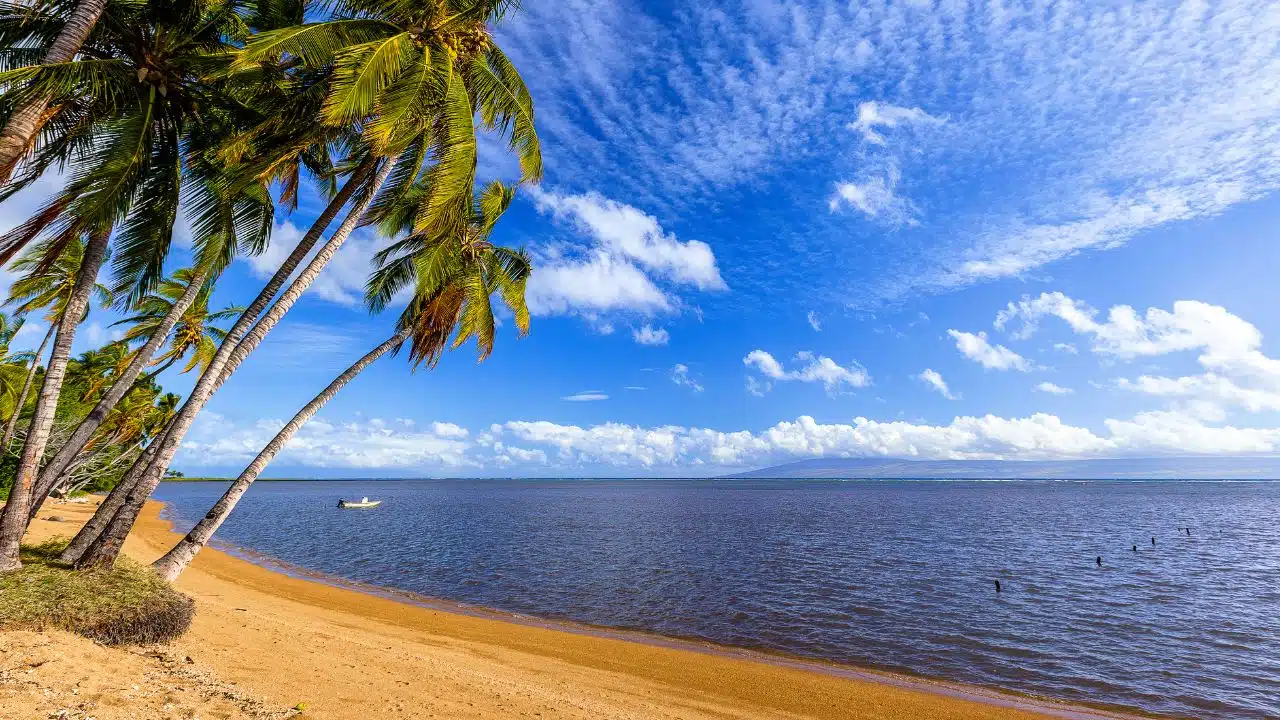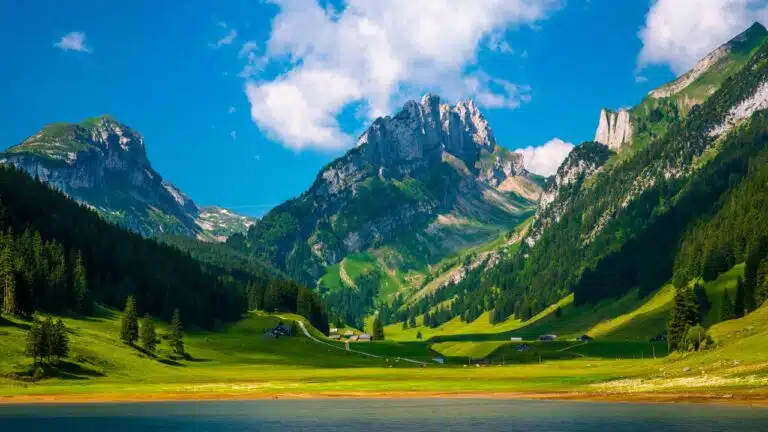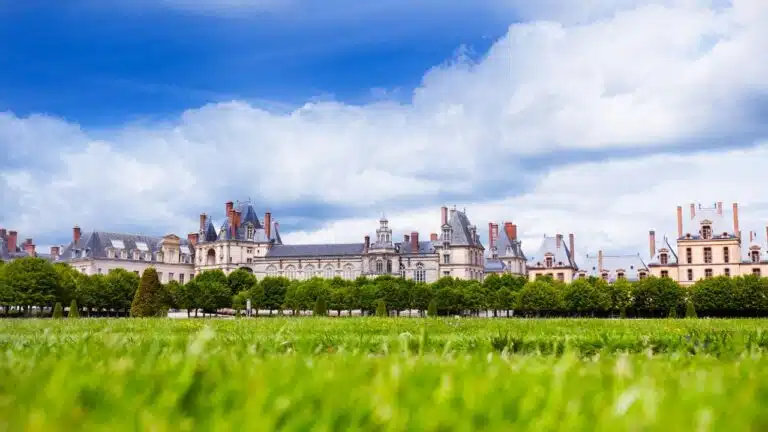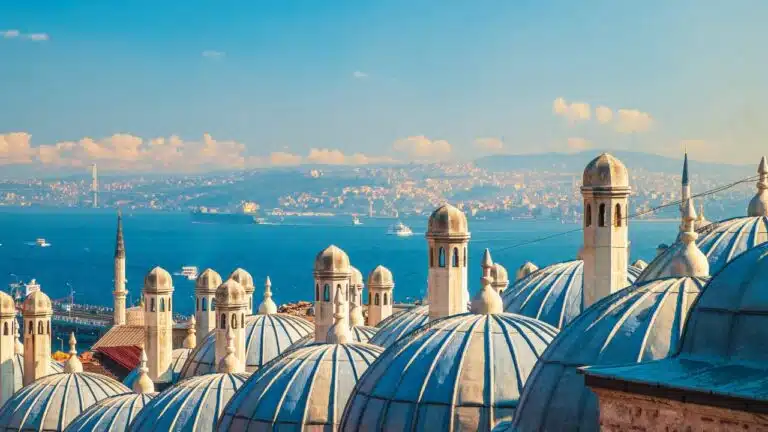The lack of a single traffic light or megamall might dissuade some from visiting the Friendly Isle, but for those who love to travel off-the-beaten path, Molokai awaits. Undeveloped and largely untouched by commercialization, Molokai’s treasures lie in its natural beauty more than any artificial structures or features. And nowhere is that more apparent than the sandy beaches dotting Molokai’s shores.
Molokai beaches shine with glittering white sand, glorious panoramas, and some of the most sublime settings on the Hawaiian Islands. Prepare to discover untouched paradise with this guide to the most enchanting Molokai beaches.
Table of Contents
- The 17 Most Breathtaking Beaches on Molokai
- 1. Papohaku Beach Park
- 2. Pohaku Mauliuli Beach
- 3. Dixie Maru Cove (Kapukahehu Beach)
- 4. Kumimi Beach (Murphy’s Beach)
- 5. Kaupoa Beach
- 6. Mo’omomi Beach
- 7. Puko’o Beach
- 8. Kawakiu Beach
- 9. Kawa’Aloa Beach
- 10. Waialua Beach
- 11. Kepuhi Beach
- 12. Sandy Beach
- 13. Halawa Beach Park
- 14. Po’olau Beach
- 15. Kakahaia Beach Park
- 16. One Ali’i Beach Park
- 17. Kamalo Wharf Beach
- Which Side of Molokai Is Best?
- Does Molokai Have Black Sand Beaches?
The 17 Most Breathtaking Beaches on Molokai
Unlike the many other beaches of the Hawaiian Islands, Molokai beaches are unique because they’re not always easy to get to. And therein lies their beauty.
You won’t find many safe swimming beaches here. Instead, you’ll discover isolated gems, many of which appear seemingly unsullied by human hands. So, let’s dive into the most magnificent Molokai beaches you can’t miss.
1. Papohaku Beach Park
Papohaku Beach is also called Three Mile Beach. As you might have guessed, that’s because Papohaku Beach stretches out for three miles, making it one of the largest white sand beaches in Hawaii.
Papohaku Beach isn’t considered a swimming beach, but it is one of the best beaches in Molokai to unwind. Never overcrowded, visitors can stretch out without watching their elbows and enjoy the scenic views of Oahu in the distance. The beach boasts plenty of amenities, from campsites to picnic tables, making your decision to spend the day here that much easier. Plan to spend your time strolling the beach, hiking to the viewpoints, and drinking in the views of a magical Molokai sunset.
2. Pohaku Mauliuli Beach
Molokai bursts with gorgeous white sand beaches, and the two sandy beach coves that make up Pohaku Mauliuli Beach are another stunning example. The beach’s name, Pohaku Mauliuli (black rock), was lifted from the neighboring cinder cone volcano. While it may seem ill-fitting for a white sand beach, the sandy shore is spotted with loose black rocks that give credence to the name.
You may be able to carve out a space for sunbathing, but the coves call for exploration. The sea is perfect for swimming and snorkeling when the water is calm. Beachcombers will also find tidepools fronting one of the coves. However, the beach’s main highlight is the view from the large bluff. Overlooking the two coves, the cliff offers a dramatic panorama of the shore and unending sea.
3. Dixie Maru Cove (Kapukahehu Beach)
Originally, this beach was named Kapukahehu Beach. That was until a Japanese boat named Dixie Maru wrecked near the beach, which then became known as Dixie Maru Cove or Dixie Maru Beach.
Because of the reef protecting the cove, the waters at Dixie Maru are calmer than almost anywhere else on the island, making it one of the best swimming beaches in Molokai. This is especially true in the summer when the water is relatively tranquil. However, when the surf’s up, it’s a good idea to stay out of the water; there are no lifeguards here.
Thanks to its location in west Molokai, Dixie Maru Cove sees little foot traffic, making it an excellent beach to visit if you want to enjoy a quiet and peaceful beach day.
4. Kumimi Beach (Murphy’s Beach)
A lovely, narrow beach tucked away on Molokai’s southeast shore, Kumimi Beach has many names: Murphy’s Beach, 20 Mile Beach, George Murphy Beach, and even Jaycee’s Park. While the abundance of monikers may confuse visitors, residents on the island know this golden sand beach as a local favorite. The beach park sports pavilions and tables with barbecue grills, while waving palms shade the thin strip of white sand.
Unlike other beaches on Molokai’s southern coast, Kumimi Beach boasts clear waters on calm days, perfect for a refreshing swim or snorkeling below the water. The reef hosts several exotic fish, including long-nosed butterfly fish.
Kumimi Beach promises a casual day of beach fun before you dive into more exciting adventures on Molokai.
5. Kaupoa Beach
Two-crescent-shaped golden sand beaches combine to create the idyllic setting of Kaupoa Beach. Located roughly a mile from Dixie Maru Beach, you can park there and hike to this empty shore. Since the Kaupoa Beach Village closed in the early 2000s, it rarely sees visitors, guaranteeing your own private beach.
Summer is the best time to enjoy this melancholy spot on Molokai’s west shore. The calm waters are excellent for swimming and snorkeling, but you should always exercise caution when alone. During winter, the surf picks up, and the water grows dangerous. Numerous ships in the past were dashed apart on the rocks surrounding Kaupoa Beach.
Both eerie and beautiful, Kaupoa is the place to stroll along the water’s edge and bask in the feeling of being utterly alone.
6. Mo’omomi Beach
The beauty of Mo’omomi Beach is hard to put into words. Like most beaches on Molokai, you’ll need a 4-wheel-drive vehicle to get to it, making it a bit of an effort. But the magic is palpable the moment you enter Mo’omomi Preserve and step foot on the beach. Centuries-old sand dunes stretch for miles in some directions. Tradewinds carry the sands from Mo’omomi Beach further inland to form what’s become known as the Desert Strip.
The beach and the dunes provide homes for rare plants and endangered animals like the Hawaiian green sea turtle, which nests on the white sand beach.
The roaring wind and crashing waves drown out almost all else, leaving you to soak in the feeling of solitude. Once you go, it won’t take the winds long to erase your steps from the shore.
7. Puko’o Beach
This paradisiacal beach features not one but two beaches tucked away on Molokai’s east shore. They sit directly opposite each other, with the east side sporting clear waters and a bigger beach while the west side is smaller with cloudier water. When the ocean is calm, it’s one of the better swimming beaches on Molokai and a great spot to swim safely or snorkel in the coral reef just offshore.
Undoubtedly though, the highlight of this beach is the view. Clear days reveal glimpses of Maui and Lanai in the distance.
Puko’o Beach demands you settle in for a picnic and soak in the views of this gorgeous Molokai coast.
8. Kawakiu Beach
There is no shortage of beaches on Molokai to “get away,” but if it’s true seclusion you’re after, you’ll find it on Kawakiu Beach. The northernmost beach on Molokai’s west shore, Kawakiu is only accessible via a 45-minute hike, providing a bit of adventure before the bliss that awaits on the coast.
Pearlescent white sand and shimmering turquoise waters lie waiting to take your breath away. Sheltered from the worst of the wind, Kawakiu is a safe swimming beach when the waters are calm. And when the waves are rough, you can still get your feet wet in wading pools located among the rocks.
This quiet oasis calls to those who long to soak in the sun and sand uninterrupted.
9. Kawa’Aloa Beach
Many locals consider Kawa’Aloa Beach a part of Mo’omomi Beach, as it sits just to the south. Like its neighbor, the sandy beach flaunts impressive dunes alongside oceanfront cliffs. Though the water isn’t safe for swimming due to temperamental waves, visitors can still enjoy sunbathing on the shore, combing for treasures in the sand, or hiking around the beach.
You may also notice that ocean debris often washes ashore here, but the local community frequently bands together to return it to pristine condition.
Kawa’Aloa is a wild and untamed stretch of beach, and leaving it better than you found it is something for which the community and the wildlife will thank you.
10. Waialua Beach
Not to be confused with Kumimi Beach, Waialua Beach also goes by the nickname Twenty Mile Beach, but it sits just south of Kumimi and the twenty-mile marker along route 450. The combination of golden sands, shallow waters, and shady palms delivers a classic Hawaiian beach experience.
Beginner snorkelers will delight in exploring the calm waters and working up their skills to tackle more challenging reefs elsewhere. And for those not interested in dipping fully into the water, no worries—it’s clear enough to catch the fish swimming among the coral from above.
11. Kepuhi Beach
Many of the loveliest west Molokai beaches require some effort to access, whether hopping in a 4-wheel drive or donning your comfiest pair of hiking shoes to trek across dodgy terrain. Consequently, Kepuhi Beach stands out as one of the most accessible Molokai beaches on the west end. However, don’t be fooled by the presence of the nearby store or the available showers. Kepuhi Beach is just as wild as the rest of them.
The peaceful waters that persist in the summer turn to surging waves in the winter, when only the most experienced surfers will touch them. The crashing waves make for a mesmerizing display, but the sunset is the actual show. At sundown, the sky becomes a painter’s masterpiece that’s not to be missed.
12. Sandy Beach
Sandy Beach sits a few miles up the road from Kumimi Beach, between mile markers 21 and 22. And while not the last beach on the road, it is the last beach before HI-450 turns inland to wind its way to the Hawala Valley.
Protected by a reef, Sandy Beach is one of the safest swimming beaches in Molokai. It also gets deep fairly quickly, so you don’t have to venture too far out to swim. In addition, you’ll find beachgoers bodyboarding and bodysurfing the waves.
What little the beach lacks, mostly in facilities, it makes up for in the view. Maui and Lanai loom visible in the distance, creating a spellbinding sight.
13. Halawa Beach Park
The last true stop at the end of the road, the long drive on HI-450 through Halawa Valley opens up to Halawa Beach Park. Upon arrival, two gorgeous beaches welcome visitors to the bay, Kama’alaea Beach to the west and Kawili Beach to the east. As if the drive to get here isn’t breathtaking enough, lush jungle, low dunes, and dramatic waterfalls act as a spectacular backdrop to both Kama’alaea and Kawili Beach.
Because of their remote location, you may be the only one enjoying these amazing east Molokai beaches. However, in the winter, you may just catch a few surfers taking advantage of the big waves.
14. Po’olau Beach
Great beaches aren’t all made of sandy shores or perfect swimming conditions. Molokai beaches prove that time and again and once more with Po’olau Beach. This sandy cove on Molokai’s west shore paints a pretty picture of sand, rocks, and a boundless sea.
Far from a swimming destination, with the beach and shoreline dotted with lava rocks, Po’olau Beach lends itself to a lazy day soaking in the view. So spread out, kick back, and don’t forget to bring lunch to enjoy a pleasant picnic among the sea and sky of Po’olau Beach.
15. Kakahaia Beach Park
Located on Molokai’s south shore, Kakahaia Beach Park is a beach, bird sanctuary, and park all rolled into one. This is a far cry from the royal fishpond that Kakahaia Beach used to be. However, due to the rocky sand, the beach is now most popular with fishermen and picnickers.
Designated as a National Wildlife Refuge, Kakahaia Beach Park is home to two endangered seabirds: the Hawaiian Coot and the Hawaiian Silt. Consequently, it’s one of the best beaches on Molokai for birdwatching and catching these elusive creatures in flight.
16. One Ali’i Beach Park
Just three miles outside Kaunakakai, One Ali’i Beach Park is a popular local spot. Named after an ancient Hawaiian fishpond, oneali’i means royal sands, and this sandy beach was a favorite spot for royals to play.
Split in two, one side of the park displays towering palms along the shore, a playing field, and a playground, while the other sports a greener lawn and a picnic pavilion.
Swimming conditions aren’t ideal at this beach due to the murky water, but the area is still a hotspot for fishing, picnicking, and large gatherings. And as is always the case with Molokai beaches, the views over the water are breathtaking.
17. Kamalo Wharf Beach
Kamalo Wharf Beach stands out from other Molokai beaches for one primary reason: it’s safe for swimming year-round. Of course, rough waters may prevent it now and again, but winter waves won’t disqualify you from taking a dip off Kamalo Wharf, even in mid-January.
On top of the excellent swimming conditions, Kamalo Wharf has another big ace up its sandy sleeve. The view from the beach is nothing short of spectacular, offering a stunning panorama that spans the Mt. Kamakou volcano, Maui, and Lanai.
Which Side of Molokai Is Best?
The east and west sides of Molokai couldn’t be more different, making your selection a personal choice. The east end promises lush jungles, cascading falls, and jaw-dropping beaches with views of Maui and Lanai. The west end offers less greenery but deserted white sand beaches, turquoise waters, and towering dunes.
The west end is the ideal choice for family vacations, with miles of deserted beaches families can enjoy to themselves. But, keep in mind that with the seclusion of the west-end beaches comes a challenging journey, usually involving a hike or 4-wheel drive to get to your destination. But your reward is often a sandy beach encompassing dazzling sea views and fascinating landscapes.
Does Molokai Have Black Sand Beaches?
‘Awahua Beach on the Kalaupapa peninsula has the appearance of a black sand beach. In reality, the color comes from dark sandstone, so it’s not a proper Hawaii black sand beach. However, that hasn’t stopped eager travelers from braving the hike to marvel at this secluded beach backed by the world’s tallest sea cliffs.
Like most things on Molokai, part of this beach’s magic is wrapped up in its seclusion. Because of its inaccessibility, a guided tour is the only way to get to ‘Awahua Beach. It’s worth laying eyes on this beach in person, but if you’re looking for a less strenuous endeavor, Hawaii’s true black sand beaches on Maui and the Big Island may have what you’re looking for.



